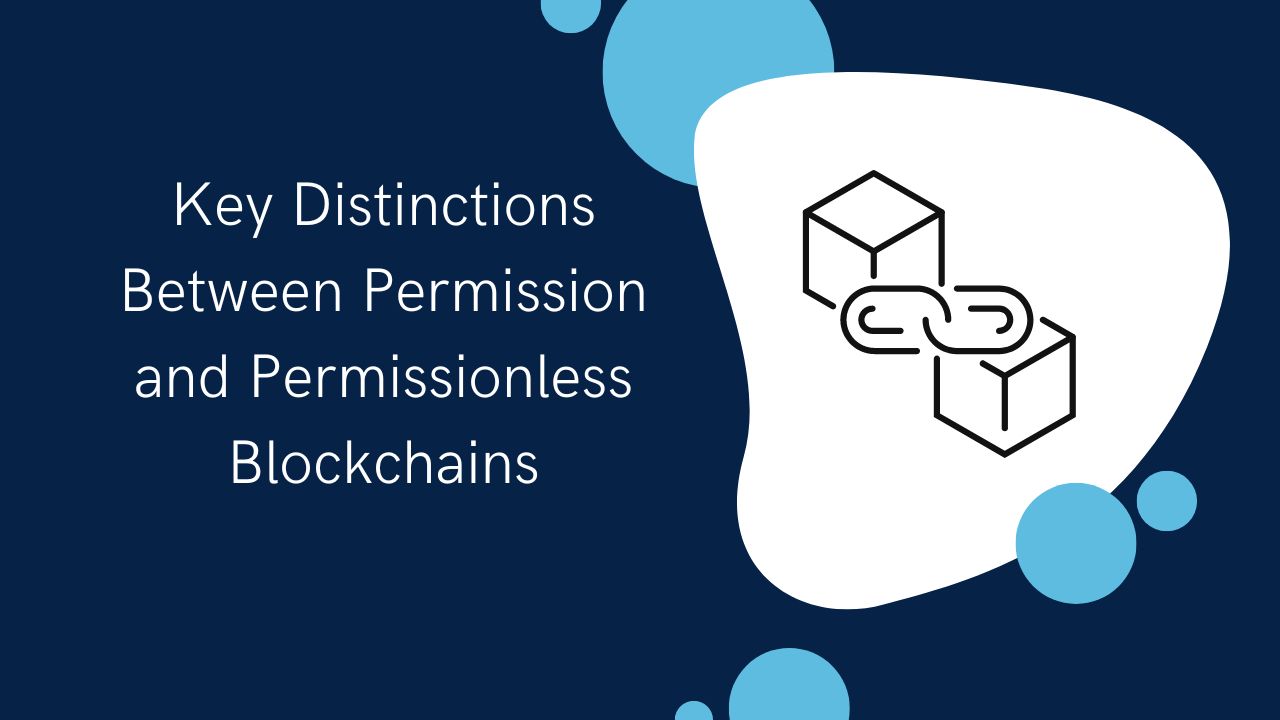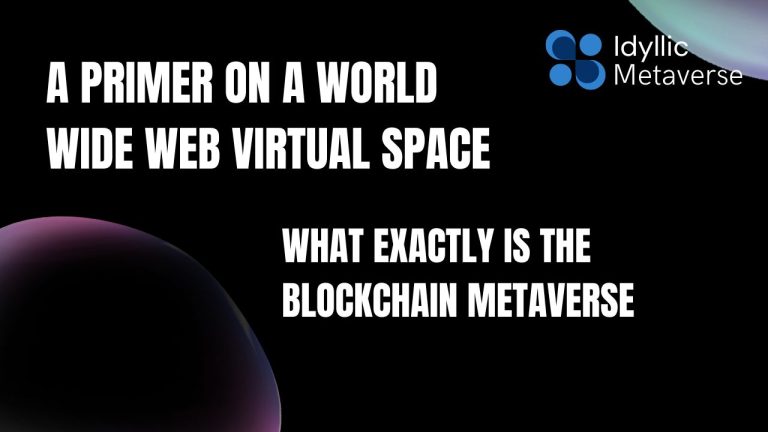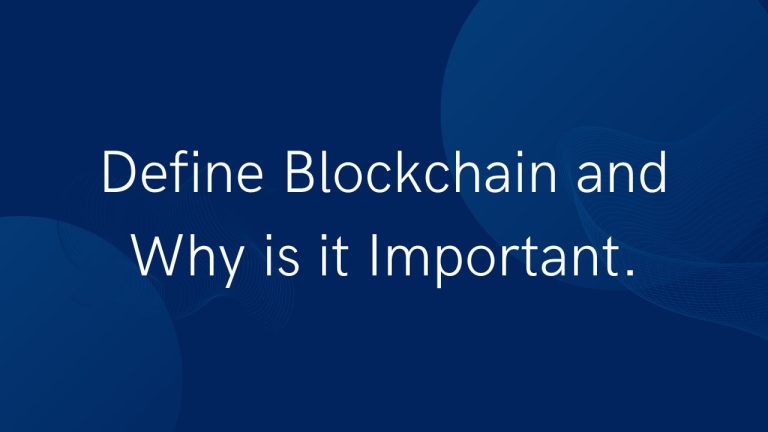Key distinctions between permission and Permissionless blockchains
Overview of Permission and Permissionless Blockchains.
A distributed, decentralized digital ledger of transactions is known as a blockchain. On the aforementioned blockchain, this ledger is widely replicated and dispersed across a network of computers.
Technically speaking, decentralized data storage is possible with blockchains. Blockchain is a distributed system, making it nearly impossible to manipulate, cheat, or hack.
As you may already be aware, the first blockchain-based cryptocurrency was Bitcoin (BTC). Because it lets data be shared openly among users, enabling network members to independently check and validate transactions, it soon gained popularity in the crypto world.
The blockchain’s blocks are made up of transactions. Every time a new transaction occurs, a record of it is added to the ledger of each participant. Consequently, distributed ledger technology, or DLT, is the name given to this kind of decentralized database. A hash is used to record transactions on the blockchain, a type of DLT (cryptographic signature).
DLTs, to put it simply, are a collection of frameworks and technologies that enable distributed designs. permission and Permissionless blockchains are two popular concepts, which we shall go into more detail about in this article.
Look at the differences between Permission and Permissionless blockchains
Within the blockchain ecosystem, there are two unique types of blockchains: permission and permissionless Blockchains. Each has its own characteristics and use cases. Here are some significant variations between them:
Differences between permission and permissionless blockchains.
- Access Management
Permission Blockchains: Access is limited to a predetermined participant group. Used most frequently in workplace and consortium settings where there is already a high level of participant trust.
Permissionless blockchains: Everyone is welcome, and there are no limitations on who can join or leave the network.utilized frequently in open blockchain networks like Bitcoin and Ethereum.
- Transparency.
Permission Blockchains Blockchains: They frequently have limited transparency, allowing only authorized users to see the content of the blockchain. Appropriate for applications that demand a certain level of anonymity.
Permissionless blockchains: Allow anyone to observe the entire transaction history and provide total transparency.Ideal for situations where the absence of a centralized authority is essential for openness and trust.
While both permission and permissionless blockchains have their benefits and downsides.

What is a blockchain with permissions?
Blockchains with permissions are either closed or include an access control layer. Participants are only permitted to take actions that they are authorized to take thanks to this additional security measure.
A user would require authorization from the network owner to join the network under a permission blockchain. Technically, a user can only access information on the blockchain if they are permitted to read, write, and access it. A private permission blockchain establishes the roles that determine what each user can access and how they can contribute to the blockchain.
Customization is also supported through a permission blockchain. As a result, identity verification may be used to grant access to the permission network rather than requiring each user to be approved by the network owner. Ideally, users would still be restricted to specific network functions depending on the rights set forth by the permission and permissionless blockchains.
Permissioned blockchains, also known as “private blockchains” or “permission sandboxes,” are thought of as being somewhat decentralized. This is due to the network’s distribution among known participants, unlike Bitcoin.
Ripple, a sizable cryptocurrency that provides permission-based roles for network users, is a good example of a permission blockchain. Many companies use permission blockchain networks because they let network administrators set up limitations and change settings as necessary.
How does a permission blockchain implement blockchain consensus?
Unlike permissionless blockchains, a permission blockchain does not employ the same consensus methods. Organizations that use permission blockchains frequently employ consensus models like federated, round-robin, and Practical Byzantine Fault Tolerance (PBFT).
- PBFT consensus: PBFT is a consensus algorithm that relies on voting. As long as the required minimum percentage of nodes are operating honestly and properly, the network’s security is assured in this architecture.
- Distributed opinion: Each permission and permissionless blockchains node in a federated consensus trusts a certain group of signers. By using a single block generator to receive, hold, and filter transactions, these signers aid the nodes in reaching the consensus stage.
- Topped majority: In a round-robin consensus, nodes are chosen to form blocks in a pseudo-random manner. Before a node may be selected once more to add a new block, it must wait for many cycles.
Features of a blockchain with permissions
Security is closely related to some of the distinguishing qualities of a permission blockchain. Permissioned blockchains are viewed as more secure alternatives to open blockchain platforms like Bitcoin because they have an access control layer.
As a result, those who need to establish roles, confirm identities, and safeguard access within a network prefer it. Additionally, not anonymous, permission blockchains are typically created by private groups and enterprises.
Actions are approved by a secret society.
Permissioned networks do not rely on consensus, in contrast to permissionless networks. Instead, choices are made by the network’s proprietors at a single, predetermined level.
Federalism is a fluid concept.
Permissioned blockchains can be totally centralized or partially decentralized, in contrast to Bitcoin, which is a completely decentralized blockchain. The network’s degree of decentralization and consensus procedures are often decided by the participants.
Truth is optional.
Permissioned blockchains do not need to be transparent, in contrast to permissionless blockchains. Transparency is optional because the majority of permission blockchain networks are designed to be opaque for security reasons. Transparency levels are typically influenced by the objectives of the company managing the blockchain network.
Permissioned blockchain’s benefits and drawbacks
Permissioned blockchains have advantages over public ones due to exclusivity, but there are certain drawbacks as well. Here is a contrast:
Permissioned blockchain benefits
The highest-ranking benefit of permission blockchains is their high level of security and anonymity. An outsider cannot access or modify transaction information without first being confirmed or given authorization.
Flexibility in terms of decentralization is another benefit. Businesses have more freedom to join without having to worry about the hazards associated with a highly centralized network thanks to its gradual or complete centralization options.
They may also support modifications and integrations based on the requirements of an organization and are extremely adaptable. Finally, because only a small number of nodes are required to handle transaction verifications, they are both scalable and high-performing.
Permissioned blockchain drawbacks
Despite the benefits, we listed above, this kind of blockchain still carries significant dangers and drawbacks.
The risk of corruption and the network’s lack of openness are mostly to blame. There is a considerable possibility of collusion and overriding of agreement precisely because it is restricted to only select people and is managed by a private group. As a result, the network’s administrators can quickly change the consensus rules.
It is sufficient to note that while a permission blockchain is considered secure, its security also depends on the integrity of its users. An individual or group influencing the network can change data to their advantage. This makes the network’s lack of openness a significant drawback.
Additionally, they are subject to restriction and censorship, particularly for companies that must adhere to strict laws and regulations. As a result, there is no freedom to use the uncensorable characteristics of public blockchains.
What is a blockchain without permission?
On the other end of the spectrum is a permissionless blockchain, a different type of DLT paradigm. Today, the majority of notable cryptocurrencies, including Bitcoin, run on permissionless blockchain networks.
True to the name of the service, anyone can use the network and access information. It is public and decentralized, to put it briefly. The term “permissionless” refers to the absence of gatekeepers and censors. No identifying documentation or Know Your Customer (KYC) checks are required in order to access the blockchain.
As long as the protocol allows it, anyone can technically utilize it to accomplish anything they want within the network. Permissionless blockchains are regarded to more closely resemble Satoshi Nakamoto’s initial idea for the blockchain.
Because they are now accessible to the whole public, permissionless blockchains frequently trade off speed for security. Generally speaking, they move more slowly than their smaller, counterparts with permission.
So how do blockchains that do not have permission function? On these blockchains, the transaction data is typically verified by the general public. Because there is no governing body or authority, the network depends on the general public to agree that transactions are legitimate.
Features of blockchain without permission
Permissionless blockchains differ from permission blockchains in that their users’ identities are concealed and their transactions are transparent. They support open-source development as well.
Decentralization
Blockchains without permission are often decentralized. As a result, a single entity cannot modify the ledger, stop the network, or change its protocols on its own. Consensus procedure, which relies on the majority and their sense of integrity, is firmly rooted in this. Usually, for such a consensus to be reached, more than half of its users must concur.
Transparency
In a network with no access restrictions, users can access any kind of data (except private keys). Transparency of transactions in a permissionless network is valued because the entire nature of a decentralized network is to shun central authority structures.
Anonymity
Permissionless blockchains do not request users’ identification details or personal information when they create an address, in contrast to permission networks.
Tokens
Blockchains without permission allow the use of tokens or digital assets. These frequently act as inducements for users to engage with the network. Depending on the market, assets and tokens may appreciate or depreciate over time.
Benefits and drawbacks of permissionless blockchain technology
Blockchains without permission are very decentralized and open. Naturally, they have a range of benefits and drawbacks. Here is a contrast:
Benefits of permissionless blockchain technology
The great level of openness offered by a permissionless network is one of its main benefits. Transparency enables quick settlement between unidentified parties because it is highly decentralized and spreads throughout a vast network.
Of course, decentralization has advantages. One of them is that data is not kept in a single central repository, making the public record secure, trustworthy, and available to everyone. It is also regarded as being nearly unhackable as a result.
Because it is so widely available to users worldwide, the network is also safe and immune to censorship. As a result, it will be challenging for attackers to access the network. The network’s consensus processes cannot be overridden without attacking 51% of it, and there is no single repository to focus on.
Permissionless blockchain’s drawbacks
The majority of a permissionless blockchain’s drawbacks have to do with how it performs. The amount of power needed to run a permissionless blockchain is one of its main obstacles. To reach a consensus, a lot of energy and computer power is needed.
It is frequently slower than permission networks and more difficult to scale because of how big the network is in general. Permissionless blockchains use a lot of energy and computational resources due to their scale and the necessity to verify transactions. As a result, several businesses find it challenging to use permissionless networks as an enterprise solution.
Due to the public nature of transaction information, there is also less privacy.
In some ways, anonymity might be seen as a drawback of permissionless systems. In the network, anyone can participate, so it is impossible to easily weed out bad actors or scammers.
A permission blockchain’s similarities to a permissionless blockchain
Here are several traits that both blockchains possess that are common ground.
First, both are regarded as distributed ledgers, which means that numerous copies of the same data are kept scattered around the network. Both blockchains include consensus mechanisms, which allow participants to agree on issues like how transactions should be validated or how the ledger should appear.
Aside from being partially immutable for permission networks, both blockchains are also immutable. Because these networks are immutable, data saved there can’t possibly be changed unless consensus methods are overridden or the system is compromised.
Which blockchain, permission or permissionless, is best for you?
The two blockchain topologies “permission and permissionless blockchains” are both more appropriate for specific applications since they have different use cases.
For instance, unpermitted blockchains are more appropriate for usage in financial applications. It is also well suited to circumstances that call for significant decentralization, such as:
- Giving and crowdsourcing
- Digital asset exchange
- cryptocurrency storage
However, permission blockchains are suitable for applications that require a high degree of security and anonymity, such as:
- Authentication of identity
- Claims resolution
- Supply-chain Management
As with anything, it is advised to weigh the advantages and disadvantages of both DLT paradigms before investing your money in them. Researchers Solat, Calvez, and Nat-Abdesselam made a compelling argument for why permissionless blockchains are superior to permission blockchains in a study that was published in the Journal of Software.
The paper “Permission and Permissionless Blockchains: How and Why There Is Only One Right Choice” makes the following arguments:
Recalculating upcoming blocks in a closed network may be an option.
By validating transactions and guarding against tampering with historical transactions, a blockchain system maintains the integrity of data. When one block is changed in a permissionless network, the rest of the consecutive blocks become invalid.
The researchers claimed that “it is conceivable to recalculate all the next block such that all updated blocks will become legitimate again” in a permission network. In other words, the integrity and security of the data cannot be guaranteed and transactions cannot be protected against fraud by simply chaining blocks together based on the hash of the preceding one.
Blocks can’t just be connected in a chain.
It is insufficient to chain blocks together depending on the hash of the previous block. This strategy “cannot assure the integrity and security of the data and protect transactions against manipulation,” according to the researchers’ study.
The researchers claim that this makes the chaining of transactions meaningless and transforms this kind of blockchain into an “unhelpful structure.” The drawbacks of permissionless blockchains as well as the appeal of permission blockchains were acknowledged by academics. However, they emphasize that closed networks are still not a good choice despite the difficulties of scalability and performance with permissionless blockchains.
FAQS:
What are the restrictions of the blockchain with permissions?
Permissioned blockchains have many drawbacks, including the fact that they are susceptible to hacking because they need internet connectivity. Some individuals may employ immutability strategies on purpose, including validation via consensus methods and cryptographic security measures.
What is an example of a permission and permissionless blockchains?
Examples of permissionless blockchains, which are often open and decentralized, include Bitcoin, Ethereum, and BNB Chain. As opposed to open blockchains, permission blockchains require invitations to join. They’re designed for specific use cases and are frequently employed in private corporate settings.
What are the design issues for Permissioned blockchains?
The paper introduces a permission BC system and examines a number of design challenges, such as control messages, block size, and block creation time window size. Identification of the compromised nodes found during the consensus protocol is also important.
Permissioned Blockchains Are they quicker?
security and effectiveness. Because they limit the number of users who can access and join the permission blockchain, permission blockchains are faster than permissionless blockchains.







